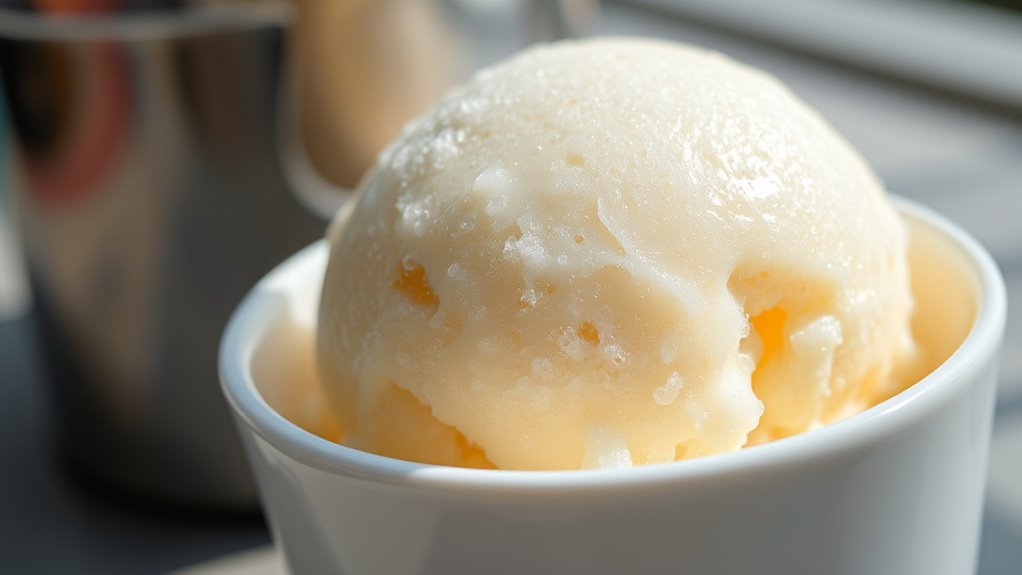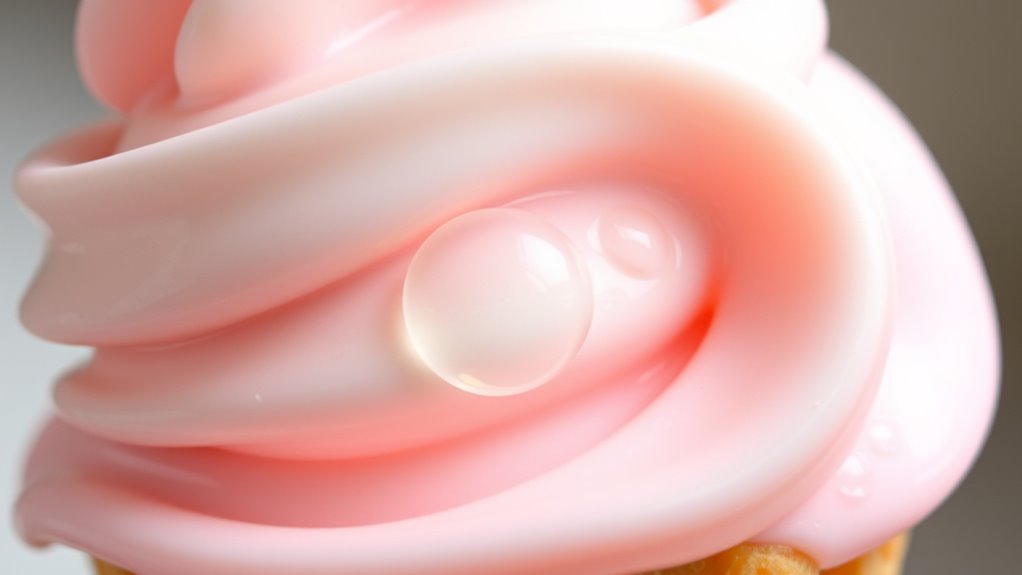Revealing the secret science of overrun means understanding how air affects your gelato’s texture and flavor. If you incorporate too much air, your gelato becomes airy and icy, while too little results in a dense, heavy dessert. Proper overrun elevates flavor, creates a melt-in-your-mouth experience, and improves visual appeal. Mastering this balance is key. Keep going if you want to discover how controlled techniques and ingredients can perfect your gelato’s consistency and taste.
Key Takeaways
- Proper overrun balances air and density, ensuring a light, creamy texture without making gelato icy or overly dense.
- Excessive air incorporation leads to an airy, less flavorful gelato, while insufficient air results in a heavy, chewy consistency.
- Controlling churning speed, duration, and stabilizer use directly influences the amount of air integrated during freezing.
- Mastering overrun enhances flavor distribution, visual appeal, and shelf stability of the gelato.
- Precise technique and equipment adjustments are essential to achieving optimal overrun for ideal gelato quality.

If you’ve ever tasted gelato that feels overly airy or icy, you might be experiencing an overrun issue. Overrun refers to the amount of air incorporated into the gelato during the churning process. Too much air can dilute the richness of flavors and compromise flavor stability, making your gelato taste bland or insipid. Conversely, too little air can lead to a dense, heavy texture that feels less inviting. Finding the right balance is key to achieving a smooth, creamy consistency that enhances the overall experience.
When overrun is properly managed, it plays a critical role in texture enhancement. A well-aerated gelato feels light and airy on the palate, creating that signature melt-in-your-mouth sensation that keeps people coming back for more. Proper air incorporation also helps distribute flavors evenly throughout each serving, ensuring every spoonful delivers a consistent taste. If the overrun is too high, the gelato becomes excessively fluffy and icy, diminishing the richness and making it less satisfying. On the other hand, minimal overrun can result in a dense, chewy texture that lacks the delicate, velvety feel customers expect from good gelato.
Understanding how to control overrun involves paying close attention to your churning process and ingredients. Using the right amount of fat and stabilizers can influence how well air is incorporated, affecting both flavor stability and texture. For example, stabilizers help maintain the structure of the gelato, reducing the risk of ice crystals forming and ensuring a consistent, smooth texture. When you strike the right balance, you preserve the intense flavor profiles and prevent them from being watered down by excessive air. This balance also prolongs flavor stability, keeping your gelato tasting fresh longer and maintaining its appealing characteristics over time.
Additionally, the technique of churning affects overrun considerably. Over-agitating can introduce too much air, leading to a fragile, icy gelato, while under-churning leaves it too dense. By monitoring and adjusting your churning speed and duration, you can tailor the overrun to suit your desired texture and flavor profile. This control not only ensures a creamy, stable gelato but also enhances its visual appeal, making it more enticing.
Ultimately, mastering overrun is about understanding how air impacts both flavor stability and texture enhancement. When you get it right, your gelato becomes a perfect harmony of rich flavor, smooth consistency, and inviting appearance. It’s a subtle science that, when done well, transforms a simple dessert into an unforgettable treat that delights every sense. Automation in food production and the use of advanced churning technology are helping artisans and commercial producers achieve this precise control more consistently.
Frequently Asked Questions
How Does Overrun Affect Gelato Texture and Mouthfeel?
Overrun directly impacts gelato’s texture and mouthfeel by controlling air incorporation. Higher overrun adds more air, making your gelato lighter and creamier, which enhances its overall texture. Conversely, low overrun results in a denser, richer feel. You can tweak the overrun level to achieve your desired mouthfeel, ensuring your gelato is perfectly smooth and satisfying. Proper air incorporation is key to balancing creaminess and richness in every scoop.
What Is the Ideal Overrun Percentage for Premium Gelato?
For premium gelato, you want an overrun percentage around 25-30%. This level of overrun optimization guarantees your gelato remains dense and creamy while maintaining a light, airy texture. Use air incorporation techniques that control bubble size and distribution, preventing over-aeration that could compromise quality. By balancing these factors, you achieve a perfect mouthfeel and rich flavor, elevating your gelato to a premium standard.
Can Overrun Influence Gelato’s Flavor Intensity?
Did you know that over 50% air incorporation can dilute gelato’s flavor? Yes, excess air can weaken the intensity of your favorite flavors by creating flavor dilution. When you add too much air, the richer taste diminishes, making the gelato less vibrant. So, controlling overrun is essential; it influences not just texture but also how strong and memorable your gelato’s flavor remains in every spoonful.
How Is Overrun Measured During Gelato Production?
You measure overrun during gelato production using specific measurement techniques that involve comparing the volume of the mixture before and after freezing. To do an overrun calculation, you record the initial liquid volume, then determine the final volume after churning. Subtract the initial from the final, divide by the initial, and multiply by 100 to get the percentage of overrun. This helps you control air content for perfect texture and flavor.
Does Overrun Impact the Shelf Life of Gelato?
Imagine your gelato’s shelf life as a fragile balloon—air incorporation and bubble stability play crucial roles. Overrun influences how well air is integrated, affecting texture and freshness. Too much or too little air can cause rapid spoilage or freezer burn, shortening shelf life. By controlling overrun, you guarantee your gelato remains delicious longer, maintaining its quality through proper bubble stability and preventing premature deterioration.
Conclusion
Now that you understand how air influences your gelato, you can craft a truly enchanting treat. Think of overrun as the subtle touch that elevates your creation, giving it just the right whisper of lightness. When you master the balance, your gelato becomes more than just a dessert—it’s an experience. Embrace the gentle dance of air and ice cream, and watch your culinary magic turn an ordinary scoop into something unforgettable.









